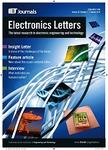版权所有:内蒙古大学图书馆 技术提供:维普资讯• 智图
内蒙古自治区呼和浩特市赛罕区大学西街235号 邮编: 010021

作者机构:Gachon Univ Neurosci Res Inst Inchon South Korea Gachon Univ Dept Biomed Engn Inchon South Korea
出 版 物:《ELECTRONICS LETTERS》 (电子学快报)
年 卷 期:2016年第52卷第10期
页 面:801-U45页
核心收录:
学科分类:0808[工学-电气工程] 0809[工学-电子科学与技术(可授工学、理学学位)] 08[工学]
基 金:National Research Foundation of Korea (NRF) - Ministry of Education, Science and Technology of the Republic of Korea [NRF-2014 M3C7033998] Korea Health Technology R&D Project through the Korea Health Industry Development Institute (KHIDI) - Ministry of Health and Welfare of the Republic of Korea [HR14C-0002-010014]
主 题:radiowave propagation coils radio transmitters radio receivers low-pass filters high-pass filters band-pass filters biomedical MRI finite difference time-domain analysis biomedical communication biological subject resonance frequency radio wave propagation birdcage transmit-receive radiofrequency coil RF coil lowpass filter configuration highpass filter configuration bandpass filter configuration mouse body magnetic resonance imaging numerical analysis finite-difference time-domain method RF shielding cage configuration magnetic flux density 1 5 T magnetic flux density 3 0 T magnetic flux density 4 7 T magnetic flux density 7 0 T magnetic flux density 9 4 T magnetic flux density 11 7 T frequency 63 87 MHz frequency 127 74 MHz frequency 200 MHz frequency 300 MHz frequency 400 MHz frequency 500 MHz
摘 要:Radio wave propagation of three types of birdcage transmit/receive radio-frequency (RF) coils (lowpass filter, highpass filter, and bandpass filter configurations) was analysed for mouse body magnetic resonance imaging at main magnetic fields of 1.5, 3.0, 4.7, 7.0, 9.4, and 11.7 T (Larmor frequencies of 63.87, 127.74, 200, 300, 400, and 500 MHz) in terms of magnetic (|B-1|) field sensitivity and homogeneity. The observed radio wave propagation in the central axial |B-1| field, as influenced by the biological subject, was calculated numerically in the finite-difference time-domain method and compared with assessment criteria using the mean value and standard deviation. The results for different Larmor frequencies RF shielding cage configurations, and biological subject loading versus unloading were compared and are discussed in detail.